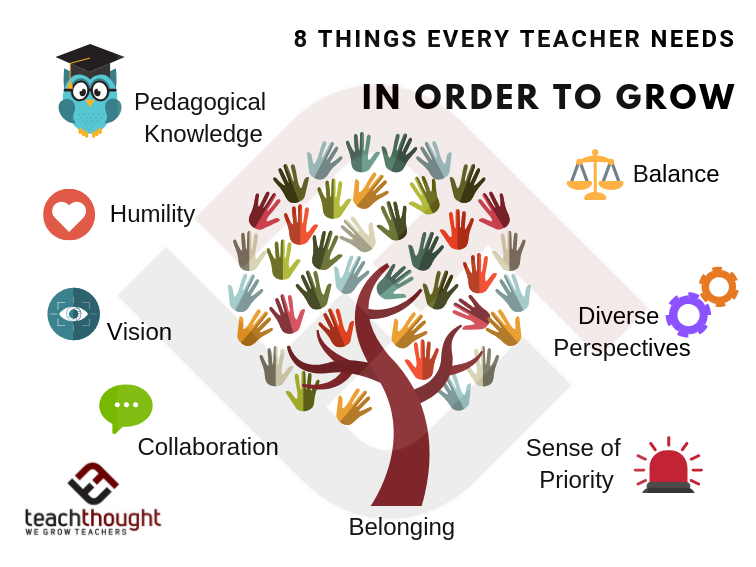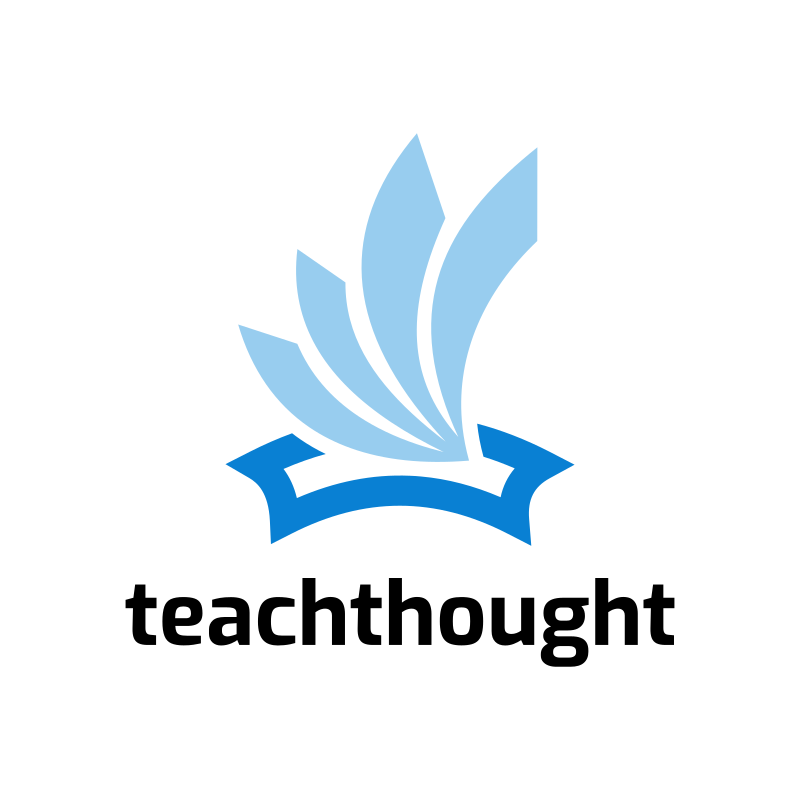
To Grow, Every Teacher Needs These 8 Things
by Terry Heick
What do teachers need to grow?
Training, books, words of encouragement, degrees and certifications, Professional Development, meetings, assistants, rules, policies, laptops–these are the traditional fare of teacher improvement.
But to truly improve teacher capacity over time in a sustainable way, it’s more about mindset (it doesn’t always have to be a growth mindset, either), curiosity, and a sense of progress and belonging. Below are eight things I’ve noticed that every teacher needs in order to grow.
8 Things Every Teacher Needs In Order To Grow
1. Humility
You’re probably very good at what you do–at least parts of it. You’re also probably very bright, compassionate, and driven or you wouldn’t have made it to whatever place you’re currently in as an educator.
But change requires self-awareness and a humble approach to your craft. Instructional strategies are great, but the ability to see yourself and the need for change–within or around you–is the most critical step in any process of growth and change.
Be honest with yourself–your strengths and weaknesses. Your needs versus student needs. Reflecting on how that lesson or activity went, or why that assessment went the way it went. Content that’s fun versus content that changes students. Admit when you were wrong, or when an idea you said was good turned out badly or vice-versa.
Honesty–coupled with humility–leads to growth.
2. Vision
Teachers who grow have the ability to see the ‘big picture’–what’s most important, the value of an idea or strategy, the drains on their own creative energy, etc. They ‘see’ what’s happening around them and learning and make adjustments and grow.
As often as possible, strive for a balance of thinking, tools, strategies, and related resources. The most popular, clicked, shared, and curated content on the internet is probably lists. Top 10 Strategies For _____, 25 Apps _____ , 8 Tips For _____, etc. This is probably because they’re easy to skim, extract takeaways, save, and move on with your life.
But to really see a change in your teaching, strive to have a balance of content—of thought leadership, tools, strategies, frameworks, and other resources that, in fragments, combine to make a fuller, clearer picture of the complexity of teaching and learning. Depending on your own expertise, experience, and comfort level, you may need more of one area and less of another and that’s fine. But resist the temptation to skip anything longer than a few paragraphs and go straight for the pretty graphics, books, blog posts, and webinars with whiz-bang titles that promise you the world.
Your time is valuable but because it is valuable, that’s all the more reason to seek out the strategy to use with the app in the learning model that followed up on the thinking in the inspiring piece you read last week. Think of your needs as a kind of spectrum or hierarchy–or even a system of needs.
And a crucial part of vision is what you see. A teacher who grows in capacity over time has the vision to see what’s working and what’s not–to separate what is and is not important (see #5) and have a clear sense of improvement and progress around the former while being able to navigate around the latter.
3. Meaningful Collaboration
It’s all well and good that you’ve found a great literacy framework or strategy, edtech tool, or framework for collaboration, but you’re only one person. Share the knowledge—and with a diverse audience of folks you think will read it, value it, and share it themselves. Start a ripple.
Share it in diverse ways. Print a copy and leave it on a colleague’s chair. Send it through email. Share it on your own blog. Use Pinterest, twitter, or some other method of socializing the thinking. And don’t just share with new teachers and friends, but your superintendent, state commissioner, neighboring principals, and perhaps most critically, parents—not just online, but people in your local community that you know and understand.
4. A Sense of Belonging
Consistently look to integrate the content you read—with committees, PD plans, professional learning communities, parents, curriculum, student work, etc. Don’t just seek to “use” things, but rather to fuse them with other important pieces of the teaching and learning process.
If you want to go fast, go alone; if you want to go far, go together.
5. A Sense of Priority
Be selective in what you read. A lot of titles and headlines promise thinking and utility that just isn’t delivered in the content itself, whether it’s a book, blog post, video, or other media. And some of it may be from reputable sources.
Be selective. There is only so much information you can consistently use. Pare down the sources—anywhere from five to ten blogs or social channels should be more than enough to support your growth as an educator and allow for change.
Just make sure TeachThought.com is on the list.
6. Diverse Ideas & Perspectives
You may tend towards content that justifies your own opinion—confirmation bias being what it is. And there’s nothing wrong with that. The bulk of your content should likely reflect the tone and philosophy of your teaching and learning worldviews.
But don’t be afraid to challenge yourself by diversifying—confronting new possibilities with a critical eye and an open mind. This is how you grow.
And as mentioned in item #1 (Balance), diversify in terms of types of content as well. Curricula, curricula, frameworks, dialogic content and conversations, and so on.
7. Pedagogical Knowledge
Knowledge is everything–it spawns creativity, potential, and purpose.
Knowledge about how your content area obviously is crucial, as is knowledge about how to actually teach (pedagogical knowledge). But also core to this is knowledge about how people learn–neurology, psychology, etc.
8. Reflection
A big part of this is time–having the time (chronological) and mental space (psychological) to make it happen in an authentic and organic way.
Take a moment and look at the work students complete, and the strategies you use to bring them to and prepare them for that work. Take a close look at how you interact with students, colleagues, and parents.
Scrutinize your curriculum, assessments, and assessment results; student engagement, and the tone of the conversations they have that you don’t lead. Look closely, think carefully, and see if you can trace back anything, from a macro perspective to a very micro strategy, to something you read, watched, or observed. Most of the time you may not be successful here, but try.
Where did this lesson come from?
The perspective that led me to trash this unit or rethink this other unit completely?
What helped me see this way of looking at mobile learning? And the potential in this assessment form? (There are many ways to measure understanding.)
Where did all this change come from, and where can I get more?
When am I at my best?
What do I need to grow?
